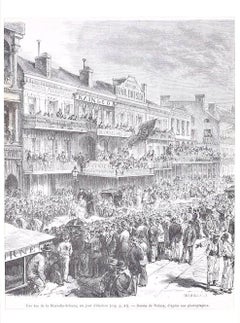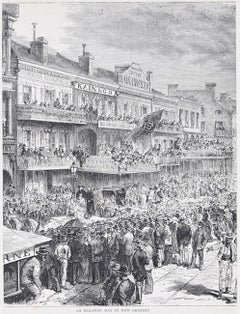Henry Theophile Hildibrand
Un jour d'élection - Original Lithograph by H.-T. Hildibrand - 1880
By Henry Théophile Hildibrand
Located in Roma, IT
, realized in 1880 by Henry Théophile Hildibrand, after a drawing from a photograph by Valnay.
Of little
Category
1880s Modern Figurative Prints
Materials
Lithograph
$268 Sale Price
25% Off
H 12.21 in W 7.88 in D 0.08 in
An Election Day in New Orleans - Original Lithograph by H.-T. Hildibrand - 1880
By Henry Théophile Hildibrand
Located in Roma, IT
lithograph on paper, realized in 1880 by Henry Théophile Hildibrand, after a drawing from a photograph by
Category
1880s Modern Figurative Prints
Materials
Lithograph
$268 Sale Price
25% Off
H 10.08 in W 7.21 in D 0.08 in
People Also Browsed
Pair of Victorian Cabinets with Taxidermy Quetzal by Henry Ward
By Henry Ward
Located in Amsterdam, NL
A pair of extremely rare Victorian display cabinets with taxidermy resplendent quetzal (PHAROMACHRUS MOCINNO), cotinga and hummingbirds, attributed to Henry Ward (1812-1878)
Engla...
Category
Antique Early 19th Century English High Victorian Taxidermy
Materials
Other
$70,430 / set
H 32.68 in W 24.02 in D 7.09 in
Petit-Monsigny Art Deco Ibis Sculpture Table Lamp, 1920
By A. Petit Monsigny
Located in Saint-Amans-des-Cots, FR
French Art Deco Bronze Sculpture Table Lamp by Adolphe Petit-Monsigny, circa 1920. An exceptional French Art Deco table lamp, circa 1920, showcasing a stunning bronze sculpture by th...
Category
Vintage 1920s French Art Deco Table Lamps
Materials
Alabaster, Bronze
Venice by Moonlight - 19th Century Oil Painting of the Grand Canal by Full Moon
By Henry Pether
Located in Gerrards Cross, GB
'Venice by Moonlight' by Henry Pether (1800-1880).
The painting – which depicts an extensive nocturnal view of the Grand Canal with the Palazzo Pisani Gritti to the left and the Dor...
Category
Mid-19th Century Old Masters Landscape Paintings
Materials
Oil
$96,150
H 33 in W 45 in D 3 in
MB 806 (Figurative Charcoal Drawing on Paper of Two Muscular Male Nudes)
By Mark Beard
Located in Hudson, NY
Figurative nude drawing made with graphite, conte crayon and charcoal on Arches paper
30 x 19 inches unframed
This unique life study drawing of two male nude models was made by Mark...
Category
2010s Modern Nude Drawings and Watercolors
Materials
Archival Paper, Charcoal, Graphite
French Quarter Scene (Behind St. Louis Cathedral - New Orleans Painting)
Located in New Orleans, LA
A Nestor Fruge watercolor of a French Quarter scene. Born in Bayou Lafourche, Louisiana in 1916, Nestor Hippoyle Fruge spent parts of his painting career in Paris, New York and Mexic...
Category
Mid-20th Century Impressionist Landscape Drawings and Watercolors
Materials
Watercolor
$432 Sale Price
20% Off
H 15 in W 10 in
Picasso, La Pique I (Bloch 1014-47; C. 113), A Los Toros Avec Picasso (after)
By Pablo Picasso
Located in Southampton, NY
Lithograph on vélin paper. Unsigned and unnumbered, as issued. Good condition. Notes: From the volume, A Los Toros Avec Picasso, 1961. Published by André Sauret, éditeur, Paris; prin...
Category
1960s Modern Landscape Prints
Materials
Lithograph
$1,036 Sale Price
20% Off
H 10 in W 13.2 in
"Pallas, Juno and Venus" etching
Located in Henderson, NV
Medium: etching. Etched by Joseph Benwell Clark after the George Frederick Watts painting. This impression on cream laid paper was printed in sepia ink in 1880 by Francois Lienard an...
Category
1880s Prints and Multiples
Materials
Etching
The Carroll- Crawford House, First Street, New Orleans Garden District
Located in New Orleans, LA
Jack Kleinberg (1946 – 2022), oil on canvas, 29”x 70”, estate stamped, unframed
Jack Kleinberg was a well known scene painter in New Orleans, and was known as an eccentric artist w...
Category
1990s Contemporary Landscape Paintings
Materials
Canvas, Oil
$7,500
H 29 in W 70 in D 1 in
Preliminary drawing for Remy de Gourmont, Couleurs, (Colors, new tales follow...
By Jean-Emile Laboureur
Located in Fairlawn, OH
Preliminary drawing for Remy de Gourmont, Couleurs, published in Le Mercure de France
(Colors, new tales follow old things), 1908
Graphite and colored pencil, 1926
Signed in pencil l...
Category
1920s Art Deco Figurative Drawings and Watercolors
Materials
Color Pencil
$3,000 / item
H 9 in W 6.25 in
Large Original Antique Print By Gustave Doré, " Satan At The Gates of Hell "
By Gustave Doré
Located in St Annes, Lancashire
Sensational image by Gustave Doré
Woodcut engraving
Published C.1880
Unframed.
Free shipping
Category
Antique 1880s English Romantic Prints
Materials
Paper
$35
H 12 in W 9 in D 0.07 in
Large Original Antique Print By Gustave Doré From Milton's " Paradise Lost ".
By Gustave Doré
Located in St Annes, Lancashire
Sensational image by Gustave Dore
Originally an illustration for JohnMilton's " Paradise Lost "
Woodcut engraving
Published C.1880
Unframed.
Crease to top left corner
Free shi...
Category
Antique 1880s English Romantic Prints
Materials
Paper
$35
H 14 in W 10 in D 0.07 in
Large Original Antique Print By Gustave Doré, " Minos "
By Gustave Doré
Located in St Annes, Lancashire
Sensational image by Gustave Doré
Woodcut engraving
Published C.1880
Unframed.
Free shipping
Category
Antique 1880s English Romantic Prints
Materials
Paper
Large Original Antique Print By Gustave Doré, " The Stygian Lake "
By Gustave Doré
Located in St Annes, Lancashire
Sensational image by Gustave Doré
Woodcut engraving
Published C.1880
Unframed.
Free shipping
Category
Antique 1880s English Romantic Prints
Materials
Paper
18th century allegorical painting of The Triumph of Beauty
Located in London, GB
Exhibited:
London, Royal Academy, 1800, no. 93
What was happening in British history painting in around 1800? In recent discussions of the emergence of a British School of history ...
Category
18th Century Old Masters Figurative Paintings
Materials
Canvas, Oil
$247,422
H 50 in W 36 in
Large Original Antique Print By Gustave Doré, " Ariel's Charge To Gabriel "
By Gustave Doré
Located in St Annes, Lancashire
Sensational image by Gustave Doré
Woodcut engraving
Published C.1880
Unframed.
Free shipping
Category
Antique 1880s English Romantic Prints
Materials
Paper
$35
H 12 in W 9 in D 0.07 in
"Four Original New Orleans Watercolor Scenes" Framed Late 20th Century Paintings
Located in New Orleans, LA
Four luscious original watercolors showing iconic scenes around New Orleans, by New Orleans/Missouri artist Hubert Hanush. "French Quarter Courtyard," with E.L. Borenstein Collection...
Category
Late 20th Century Impressionist Landscape Drawings and Watercolors
Materials
Watercolor
Get Updated with New Arrivals
Save "Henry Theophile Hildibrand", and we’ll notify you when there are new listings in this category.

